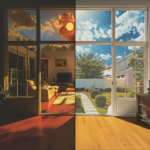Now that you’ve installed window tint on your home’s windows, you might be excited to find out whether you’re truly reaping the benefits. Although there’s no direct way to measure the effectiveness, there are a few indirect methods that can help you feel secure about your investment.
Are You More Comfortable?
The absolute best way to measure whether the tint you installed is working as intended is to judge your own level of comfort. Remember that this tint acts as an insulator in both the summer and the winter months, which means you should experience improved comfort all year round. If you feel fewer drafts in the winter and less heat radiating through the windows in the summer, then your window tint is doing its job and your investment is already beginning to pay for itself.
Have Your Energy Bills Decreased?
Another way to measure whether your tint is working is to look at your utility bills. It’s important to keep in mind that tint won’t decrease your bills drastically, but you should see an average decline of about 5% to 10% each month. Things like extreme temperatures may affect this somewhat, so rather than comparing one month to the same month the year before, try comparing your six-month averages instead. This should give you an accurate representation of whether your tint is helping you reduce your energy consumption.
Are Your Drapes Fading?
UV rays are dangerous for both you and your home furnishings. In much the same way that they can cause skin cancer, they can also fade your carpets, your drapes, and even your furniture in relatively short order. After your tint is installed, hang new drapes or curtains over one of the windows that receives the most incoming sunlight each day. In about six months, go back and look at the underside. If there’s no fading, you’ll know your window tint is doing its job by blocking most the UV light coming in through the window. This is also a good indicator that your skin is being exposed to less harmful UV rays, too.
Are You Squinting?
The glare of sunlight pouring through windows isn’t something many people really think about. After all, we’ve been conditioned to believe that allowing natural light to stream through windows is healthier than turning on artificial lights indoors. While this is true, too much light can cause a glare, causing you to squint without even realizing it. This glare can also affect television and computer screens, which creates a strain on your eyes. If you’ve noticed less squinting and fewer headaches – especially after working on the computer or watching a movie – then your window tint is working as intended.
It’s often difficult to measure the effectiveness of window tint. There’s no one tool or gadget that will give you a solid answer. The best way to make this determination is to check your own comfort levels, watch for fading on drapes and furniture, and check to see if your average utility bill is going down.






Comments are closed.